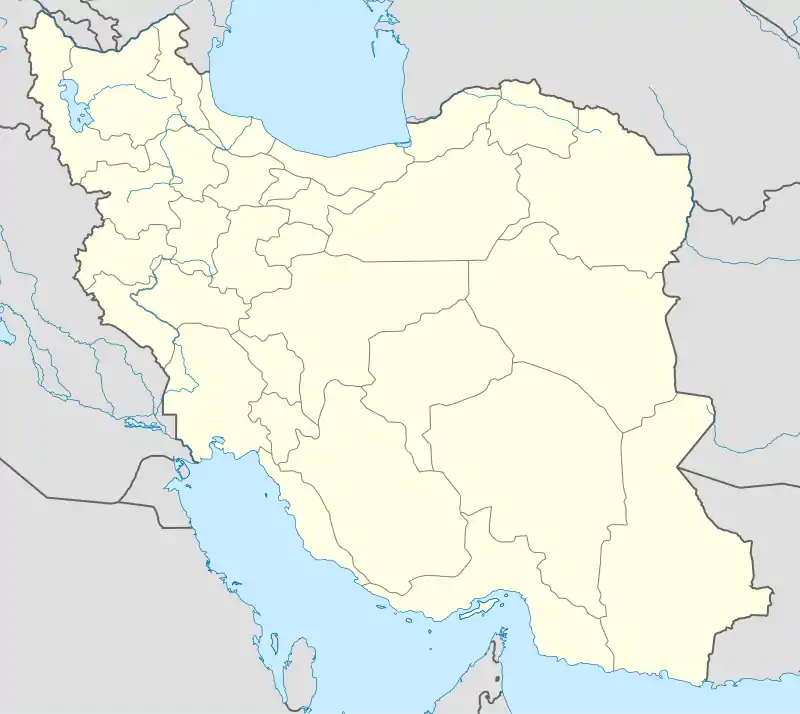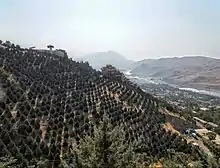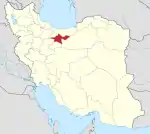Lavasan
Lavasan (Persian: لواسان, also Romanized as Lavāsān) is an affluent town in Shemiranat County, Tehran Province, Iran. At the 2011 census, its population was 28,558, in 7,645 families.[2][3] The Jajrood River flows through Lavasan. Situated 11 kilometers northeast of Tehran, Lavasan is known for its excellent weather and the luxurious mansions. The city is home to many upper-class and wealthy families. Some Iranians call it the Beverly Hills or Switzerland of Tehran.
Lavasan
لواسان | |
|---|---|
City | |
 | |
 Lavasan | |
| Coordinates: 35°49′23″N 51°37′27″E | |
| Country | |
| Province | Tehran |
| County | Shemiranat |
| Bakhsh | Lavasanat |
| Population (2016 Census) | |
| • Total | 18,146 [1] |
| Time zone | UTC+3:30 (IRST) |
| • Summer (DST) | UTC+4:30 (IRDT) |
Geography

Lavasan is located 11 kilometres northeast of Tehran on the slopes of Alborz with an area of 70 square kilometres.[4] The city of Lavasan is the capital of Lavasanat district. Together with Rudbar-e Qasran district and Shemiran, it constitutes Shemiranat County in Tehran Province.[5]
Etymology
The name of Lavasan is a Middle Persian (Pahlavi) word which means "The Mount Blade of Sunrise" or "Mountaintop of Sunrise". It refers to Mount Damavand that is located in the middle Alborz Range in the east of Lavasanat District.
History
In the 19th century, during the Qajar era, Lavasan was reportedly a large village, with some 500 houses and about 200 inhabitants.[5] It became well known during the war of the cities when many people from Tehran took refuge in the nearby towns such as Lavasan.
The two most influential parts of Lavasan are Great Lavasan (Lavasan Bozorg) and Little Lavasan (Lavasan Koochak). While the Great Lavasan was more vibrant in the early 1950s due to its location as a trade hub, the Little Lavasan has become more populated in the past few decades. Until the construction of Road_59_(Iran) and other routes to the North of Iran, Great Lavasan was a thriving city on a trade path between Tehran and the North of Iran with several prominent families owning and managing the Lar Karvansara in the (now nationalized) Lar National Park, and who were active in trades of rice and production of honey among other products, hence the name "Great Lavasan". In the ealy 1900s Great Lavasan was home to several affluent families and traders with many unique and thriving orchards. Currently Great Lavasan is less populated than the Little Lavasan due to more restricted construction regulations, as well as an influx of new residents moving to Little Lavasan from other cities. Great Lavasan has access from the Jajrood road while the Little Lavasan has access from behind the Latian Dam, their different areas include Saboo Bozorg, Saboo Koochak, Tork Mahale, Seied Paiz, etc.
Under Mohammad Reza Pahlavi, in the 1960s, a hydroelectric dam was built in the southeast of the village which is nowadays one of the water supplies of Tehran.[5]
People
The natives of Lavasan are of Caspian origin.[5] The local dialect or "vernacular" spoken by its natives is a mix of Persian and Caspian.[5]
Notable residents[6]
Climate
Lavasan has a cold semi-arid climate (Köppen climate classification: BSk) with significant continental influences.
| Climate data for Lavasan | |||||||||||||
|---|---|---|---|---|---|---|---|---|---|---|---|---|---|
| Month | Jan | Feb | Mar | Apr | May | Jun | Jul | Aug | Sep | Oct | Nov | Dec | Year |
| Average high °C (°F) | 4.5 (40.1) |
7.5 (45.5) |
12.5 (54.5) |
19.1 (66.4) |
26.3 (79.3) |
31.5 (88.7) |
34.4 (93.9) |
33.9 (93.0) |
29.5 (85.1) |
22.5 (72.5) |
14.1 (57.4) |
7.8 (46.0) |
20.3 (68.5) |
| Daily mean °C (°F) | −0.8 (30.6) |
2.0 (35.6) |
6.4 (43.5) |
12.3 (54.1) |
18.8 (65.8) |
23.4 (74.1) |
26.2 (79.2) |
25.9 (78.6) |
21.4 (70.5) |
15.3 (59.5) |
8.0 (46.4) |
2.5 (36.5) |
13.5 (56.2) |
| Average low °C (°F) | −6.1 (21.0) |
−3.5 (25.7) |
0.4 (32.7) |
5.5 (41.9) |
11.4 (52.5) |
15.3 (59.5) |
18.1 (64.6) |
18.0 (64.4) |
13.3 (55.9) |
8.1 (46.6) |
1.9 (35.4) |
−2.8 (27.0) |
6.6 (43.9) |
| Average precipitation mm (inches) | 30 (1.2) |
27 (1.1) |
32 (1.3) |
28 (1.1) |
18 (0.7) |
4 (0.2) |
2 (0.1) |
1 (0.0) |
1 (0.0) |
8 (0.3) |
15 (0.6) |
21 (0.8) |
187 (7.4) |
| Source: [7] | |||||||||||||
Gallery
See also
References
- https://www.amar.org.ir/english
- "Census of the Islamic Republic of Iran, 1385 (2006)". Islamic Republic of Iran. Archived from the original (Excel) on 2011-11-11.
- Lavasan can be found at GEOnet Names Server, at this link, by opening the Advanced Search box, entering "217990" in the "Unique Feature Id" form, and clicking on "Search Database".
- http://www.itc.nl/library/papers_2007/msc/gfm/alian.pdf
- Encyclopaedia Iranica 2017.
- lavasani genealogical tree presented in Ayatollah Sadeghi in Qum.
- "Climate: Lavasan". Climate-Data.org. Retrieved January 5, 2019.
Sources
- Encyclopaedia Iranica (2017). LAVĀSĀN.CS1 maint: ref=harv (link)



